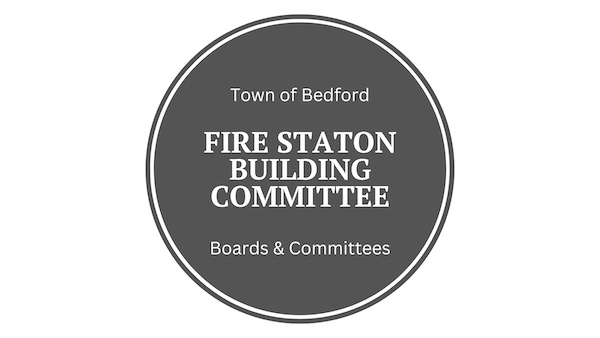The Bedford Fire Station Building Committee will present two site placement options for preliminary review by the Historic District Commission at a meeting scheduled for Wednesday, Sept. 6.
It won’t be hard to tell them apart.
The first proposal, presented by architect Sean Schmigle at Monday’s committee meeting, places the administrative offices facing the street at 139 The Great Rd., with the apparatus bays in the rear.
Option number two is the opposite, with three bays as the view from the street, and a separate ambulance bay on the east side, which reduces the view from The Great Road. Both proposals feature a circumferential drive that would allow the ladder truck to enter and exit without having to turn around.
Several members of the committee said the second plan, with the vehicles at the front, is preferable when considering safety and response. But other members pointed out that the Historic District Commission (HDC) has stipulated that retention of the area’s historic character, such as the current large swath of green, is its priority.


The HDC is central to the future of the long-awaited firehouse because the location is in the Bedford Center Historic District, where the commission has jurisdiction over external appearance.
The existing building at 139 The Great Rd. cannot be demolished without the commission’s approval, and that won’t happen until the HDC signs off on whatever is going to replace it.
That’s not on the agenda for next month’s meeting, because the designer, Kaestle Boos Associates, has concentrated on the fire station’s placement on the site as well as the interior layout. Eventually, design features and finishes as well as landscaping plans will be part of the HDC’s process.
Schmigle told the Building Committee that the size of the proposed fire station follows a thorough review of programming needs.
“We brought the building off The Great Road as far as possible to maintain greenspace up front,” he said, noting later that there will be no need for vehicles to back onto the site from the street.
The first location option, with the apparatus exiting the building in the rear, would “maintain historic imagery,” the architect said. Staff and public parking also would be in the rear of the lot. Indeed, at-large member Angelo Colasante expressed concern that a driver trying to park could meet a fire engine head-on on the access road.
The building footprint for the first option would be about 16,000 square feet. Option two is about 1,000 square feet smaller, Schmigle said, and both plans call for an additional 2,400-square-foot storage building in the back.
Besides the loop road, common to both options is a green buffer on the east border, which Schmigle said, “takes into consideration comments from abutters.”
Each version presents a building in three connected segments. The floor plan for each option shows bays for eight pieces of apparatus, contiguous to a decontamination area, operations and training areas, and firefighters’ kitchen and dining room. At the other extremity are departmental administration and a triage area for patients coming in from the street.


“We have people come in for emergencies,” said committee member Lt. Mark Daly.
On the second story of both proposals are firefighters’ sleeping area, the office for departmental leaders, a conference room, and technology office. There’s also a fitness area on a mezzanine level adjacent to the vehicle bays, and a three-story training tower alongside.
There are storage areas throughout, including in the basement, which Schmigle said will help reduce the building footprint. Total space in the first option is about 29,000 square feet; option two is 27,148, as “we really consolidated the apparatus bay.”
Acting Chief Paul Sheehan, attending his first committee meeting even before his official appointment as a member, pointed out that “this plan is definitely going to cut down on public interaction with the Fire Department.”
Asked by Select Board member Emily Mitchell about the stone wall at the front of 139 The Great Road, Schmigle said some of it will be lost to enlarged curb cuts necessary for proper entry and exit. He said, “We are going to have to alter the grade of the site to make it all work.”
He acknowledged that the station may require a variance from the planned 32 parking spaces in order to have room for snow storage.
Several committee members favored flipping the ambulance access from the east side to the west, and moving the public access west to east. They asked Schmigle to try to revise the outline in time to present it to the HDC.
Committee Chair Jeff Cohen said the option with the bays facing the street will be a “tougher sell” to the HDC. “But this definitely is going to be a safer option,” Colasante said.
The designer also told the committee that engineers have drafted a work order for removal of utility poles in front of the site. The Department of Public Works will submit them to Eversource “for them to start their engineering and work out how relocation and underground wiring will work.”
Also, Kaestle Boos is finalizing the scope of work for a traffic study, incorporating The Great Road from the intersection with Hillside Avenue and Bacon Road to the intersection with Springs and South Roads.




























Safety considerations, Option Two, is sensible. Trying to hide the function for aesthetic reasons is not sensible. I urge the various boards to endorse Option Two.